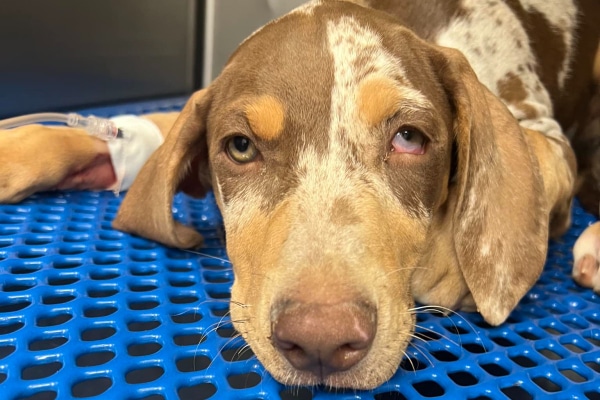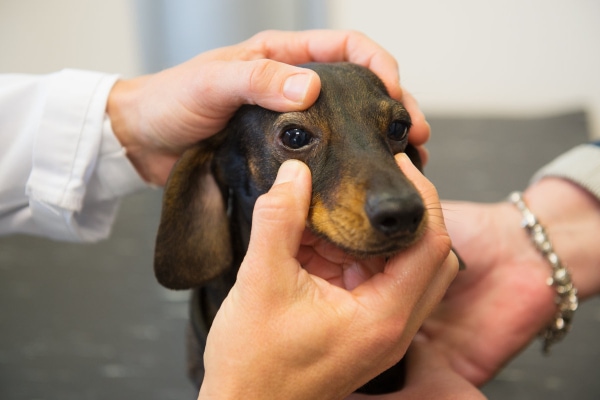In Horner’s syndrome, dogs have a collection of eye-related symptoms, including a constricted pupil, droopy eyelid, sunken eye, and/or elevation of the third eyelid. Integrative veterinarian Dr. Julie Buzby explains the anatomy and physiology behind Horner’s syndrome. And then she discusses the symptoms, causes, diagnosis, treatment, and prognosis for Horner’s syndrome in dogs.

Harold the Basset Hound wasn’t on my appointment book for eye problems. Instead, his mom brought him to see me because she was worried that her poor floppy-eared dog had yet another ear infection. And indeed he did. However, that wasn’t the only problem I found that day.
As I examined Harold, I noticed that in addition to a smelly, sore left ear, he also had a constricted pupil, elevated third eyelid, and sunken eye in his left eye. Plus, the eyelid on the affected side was even more droopy than usual.
As I explained to Harold’s mom, these signs indicated her dog had Horner’s syndrome—probably due to the inflammation in his middle ear from the ear infection. Since she seemed a bit puzzled that an ear problem could cause an eye problem (and who can blame her—it does sound odd), I took a few minutes to walk her through the ins and outs of Horner’s syndrome in dogs.
What is Horner’s syndrome in dogs?
Horner’s syndrome isn’t really a disease in and of itself. Instead, it is a collection of symptoms that can have a variety of causes. All the signs that make up Horner’s syndrome are related to dysfunction of the portion of the sympathetic nervous system which controls the eye and surrounding tissue.
The affected nerves are part of the autonomic nervous system (ANS). This is the portion of the nervous system that regulates involuntary bodily functions like breathing, heart rate, and pupil diameter. Within the ANS, there are two divisions—the sympathetic nervous system (which is the one that isn’t working in Horner’s syndrome) and the parasympathetic nervous system.
Sympathetic pathways control the “fight or flight” portion of the nervous system. And parasympathetic pathways control the “default” or “rest and digest” state of being. The relative amount of input to a particular organ from each pathway at any given time dictates how the organ reacts.
When thinking about the eye specifically, stressed or nervous dogs will have dilated pupils, wide eyelids, eyes close to the front of the socket, and lowered third eyelids. This is all due to the sympathetic pathway being in control.
Once the dog relaxes again, he or she will have normal-sized pupils, typical eyelid diameter, and neutral positioning of the third eyelid and eyeball. This restoration back to a “normal state” is thanks to the parasympathetic system opposing the sympathetic nervous system.
With Horner’s syndrome, the sympathetic pathway to the eye becomes damaged for some reason. This leaves the parasympathetic nervous system in full control of the eye and surrounding tissue. As a result, dogs with Horner’s syndrome show the effects of uninhibited parasympathetic input to the eye.
What are the symptoms of Horner’s syndrome in dogs?
This translates to the four classic clinical signs of Horner’s syndrome:
- Droopy eye (i.e. ptosis)
- Constricted pupil (i.e. miosis)
- Elevation of the third eyelid
- Sunken eye (i.e. enophthalmos)

In order for a dog to be diagnosed with Horner’s syndrome, he or she must have three or more of the above signs in the affected eye. However, some dogs with Horner’s syndrome may have additional symptoms due to the lack of sympathetic input, including:
- Warm and red ear flap (i.e. pinna) and nose on the affected side
- Increased redness to the eye and conjunctiva (i.e. pink portion of the eye tissue)
On the other hand, dogs may also show symptoms of the condition that caused the Horner’s syndrome. Signs that may accompany Horner’s syndrome include:
- Changes in mental status
- Decreased proprioception in dogs
- A dog who is wobbly and off balance (i.e. ataxic)
- Signs of vestibular disease in dogs
- Difficulty swallowing or a dog who is coughing and gagging
- Neck or forelimb pain
- Difficulty breathing or a dog who is breathing fast
- Signs of laryngeal paralysis in dogs
- Drooping face or lip
- Inability to blink
What causes Horner’s syndrome in dogs?
This list of accompanying symptoms covers many body systems due to the path of the sympathetic innervation to the eye. The nerve fibers originate in the brain and run down through the brainstem and spinal cord to the level of the chest (i.e. thorax). Then, the next part of the nerve exits the spinal cord between the last vertebra of the neck and the first four to five vertebrae of the thoracic spine.
Next, these nerve fibers travel up the neck near the carotid artery until reaching the skull. On the way to the eye and surrounding tissues, the sympathetic nerve fibers run close to the tympanic bulla (i.e. portion of the skull housing the middle ear).
Potential causes
Damage to the nerves anywhere along the pathway can lead to loss of sympathetic innervation to the eye. Therefore, some potential causes of Horner’s syndrome include:
- Trauma to the head, neck, chest, or spinal cord (e.g. being hit by a car, bite or gunshot wounds, etc.)
- Ear diseases such as middle ear infections (i.e. otitis in dogs), ear polyps, or cleaning the ear when the eardrum (i.e. tympanic membrane) is ruptured
- Tumors of the neck or chest structures (e.g. thymoma, lymphoma in dogs, thyroid or parathyroid tumors, carotid body tumors, lung tumors, or spinal cord tumors)
- Damage to the spinal cord from IVDD in dogs or FCE (i.e. spinal stroke in dogs)—fairly rare causes
- Brain tumors or damage to the brain, brainstem, or hypothalamus
- Diabetes mellitus in dogs—rare but has been reported
- Pulling hard on a leash, excessive restraint, surgery of the head or neck, or drawing blood from the jugular vein
However, about 50% of cases of Horner’s syndrome are classified as idiopathic. In other words, the vet is never able to find an inciting cause.
Which dogs tend to get Horner’s syndrome?
There is a sympathetic pathway to the eye on the left and right sides of the body. So most of the time Horner’s syndrome just happens in one eye (whichever side corresponds with the area of damage). However, with brain involvement, the dog may end up with bilateral (i.e. on both sides) Horner’s syndrome.

Middle-aged dogs seem to get the idiopathic version most often. But Horner’s syndrome can happen in dogs of any age, from puppies to senior dogs. And while it is possible in any breed, Horner’s syndrome seems to be more common in:
- Golden Retrievers
- Labrador Retrievers
- Shetland Sheepdogs
- Collies
- Doberman Pinschers
- Weimaraners
How is Horner’s syndrome diagnosed?
Most of the time, signs of Horner’s syndrome will develop quickly—usually within 24 hours. Sometimes the dog parent may notice the changes in the eye and bring their dog to the vet. Other times, the symptoms of the condition that caused the damage to the sympathetic innervation of the eye may be more evident or pressing. And the dog parent will bring the dog to the vet for those concerns.
Either way, the veterinarian will start with a complete nose-to-tail examination. And then if he or she suspects Horner’s syndrome based on noting three of the four classic symptoms (constricted pupil, eyelid droop, elevated third eyelid, or sunken eyeball), he or she may perform additional diagnostics to look for a root cause. Some potential diagnostics may include:
- Neurologic exam
- Ophthalmic exam
- Ear cytology, culture, and sensitivity
- Chest X-rays
- MRI or CT scans
- Pharmacologic tests (i.e. evaluating the response of the pupil to medications such as phenylephrine in order to determine where along the nerve pathway the damage occurred)

What is the treatment for Horner’s syndrome in dogs?
Once the vet has a better idea of the cause of Horner’s syndrome (or determines it is most likely idiopathic), he or she will talk to you about the next steps.
Since Horner’s syndrome is really a collection of symptoms, not a disease, there isn’t a treatment for it per se. Plus, Horner’s syndrome itself isn’t painful or life-threatening and doesn’t usually cause major issues for your dog.
The same can’t always be said for the causes and accompanying symptoms, though. Therefore, the goal is to treat the condition that caused the Horner’s syndrome in the first place and/or to support the dog while he or she heals.
For example, this may mean using antimicrobials to treat an ear infection or administering an anti-nausea medication like Cerenia for dogs to address nausea due to vestibular disease. The vet will determine what treatment your dog needs for the underlying condition.
Occasionally, a dog might have trouble seeing past the elevated third eyelid. In that situation, the vet may consider using phenylephrine eye drops to mimic sympathetic input. However, it is important to weigh the risks and benefits because the drops can be irritating to the cornea.
Interestingly, acupuncture for dogs may also have a place in managing idiopathic Horner’s syndrome. An article in the Journal of Veterinary Science reported that a dog with idiopathic Horner’s syndrome became symptom-free after two days of acupuncture. It is just one case, but the results are pretty amazing!
What is the outlook for Horner’s syndrome?
Along the same lines as treatment, the prognosis for Horner’s syndrome also depends on the underlying problem. Idiopathic Horner’s syndrome may go away within eight weeks for some dogs. But it can take four to six months to see improvement in other cases of idiopathic Horner’s syndrome.
Horner’s syndrome is associated with a detectable cause of nerve injury or inflammation that may resolve fully, partially, or not at all. It really depends on the extent of the nerve damage and what the inciting cause was. But in general, Horner’s syndrome secondary to cancer or brain problems carries a worse prognosis than for other causes.
Work with your veterinarian
Thankfully for Harold, he ended up being one of the many dogs whose Horner’s syndrome resolves completely. We were able to get his middle ear infection under control quickly. And although he continued to have periodic ear infections thanks to his severe seasonal allergies, he never developed Horner’s syndrome again.
Chances are good the same could be true for your pup too. If you just found out your dog has Horner’s syndrome, the best thing you can do is to work closely with your veterinarian and be patient. While your dog’s eye might look a bit odd now, in a few months, this will hopefully all be a distant memory.
Has your dog ever developed Horner’s Syndrome?
Please comment below


Hi there my 14.5 Lola girl had this happen almost a year ago, took her to ER, I was told it Horners, but never checked her ears, she does have IVDD, I did follow up with my holistic vet and they did give me some ointment for eyes, it cleared up exactly six months, now it’s been about a year, and eye looks a little cloudy on the bottom, could this also cause a cataract, just appeared suddenly.
Thanks,
Carmen
Hi Carmen,
I am sorry Lola has had so many issues with her eyes over the last year. With the cloudiness only appearing on the bottom of the eye, I would not think this was related to a cataract. Eyes are very sensitive and things can progress to a critical level quickly without much warning. I highly recommend you have her evaluated by your vet right away. Hoping for clear answers and an easy solution. Best wishes to you and your pup.
After reading your article, I believe my Saint Bernard very likely had Horner’s Syndrome. He had horrible smelly ear infection in one ear, elevated third eye lid, laryngeal paralysis and seizures. Probably had a brain tumor. Very informative article, thank you.
Dear Jackie,
I am sorry your big guy had to endure so many issues at once. I am glad the article was informative and offered some peace of mind. Thank you for the kind words and I wish you all the best. ♥
I have an 18mo rough collie. I’ve noticed from time to time when he blinks his left third eyelid doesn’t work the same as the right eye. It usually goes way over his eye compared to the right but it does go down to normal. Is this something to be concerned with?
Hi Valerie,
I am sorry your puppy is having these strange issues with his third eyelid. Unfortunately, without examining him myself it is hard to make specific conclusions and recommendations. I do think it would be wise to have this evaluated by your vet. Hoping it is nothing to worry about and you can get some peace of mind. Best wishes to you and your sweet boy.
2 weeks ago I took my 8 year old husky Hachi-Ghost to the vets they did a litmus paper test his eye didn’t show up any green on the eye so was told his eye wasn’t showing up any scratches to the eye so his eye had not been injured he told me he had Horner’s Syndrome as soon as I took him to my Dad’s car I noticed his nostril on the same side which was on the same side as eye blood started coming in from his right nostril so I took him back the the vets he had a look at him & said help keep him calm as it could be because his blood pressure had gone up.
He said it will go away by itself . Since then Hachi-Ghost hasn’t been his normal self no zoomies , not wanting to play . Sometimes he breaths like he is hyperventilating.
I came across your article & wanted to see if this has happened to other dogs with the condition . His 3rd eye lid has been visible .
Hi Tanya,
I am sorry Hachi-Ghost is having these worrisome issues. I understand your concern especially with him becoming lethargic and breathing abnormally. While Horner’s syndrome is a fairly common issue in dogs, I am not used to seeing nose bleeds, breathing problems, or changes in behavior associated with it. Without examining your boy myself, it is hard to make specific conclusions or recommendations. I am suspicious that something else may be contributing to the situation and it just hasn’t been diagnosed yet. It might be a good idea to talk to your vet about x-rays to ensure there isn’t a nasal tumor present and checking some routine lab work could offer insight. You can also ask for a consultation with a specialist if needed. Hoping for clear answers and praying for a positive outcome for your sweet boy.